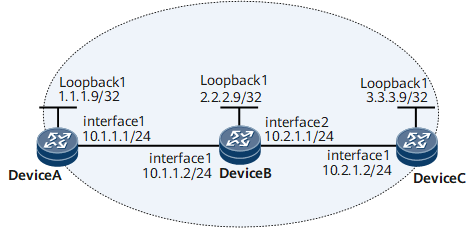Example for Configuring an NQA LSP Ping Test to Monitor MPLS Network Connectivity
This section provides an example for configuring an NQA LSP ping test to monitor MPLS network connectivity.
Networking Requirements
On the MPLS network shown in Figure 1, Device A and Device C are PEs. An NQA LSP ping test can be configured to periodically monitor the connectivity between these two PEs.
Configuration Roadmap
The configuration roadmap is as follows:
- Create an LSP ping test instance on Device A.
- Start the test instance.
Procedure
- Create an LSP ping test instance.
<DeviceA> system-view [~DeviceA] nqa test-instance admin lspping [*DeviceA-nqa-admin-lspping] test-type lspping [*DeviceA-nqa-admin-lspping] lsp-type ipv4 [*DeviceA-nqa-admin-lspping] destination-address ipv4 3.3.3.9 lsp-masklen 32
- Start the test instance.
[*DeviceA-nqa-admin-lspping] start now [*DeviceA-nqa-admin-lspping] commit
- Verify the test result.
Run the display nqa results test-instance admin lspping command on Device A. The command output shows that the ping is successful.
[~DeviceA-nqa-admin-lspping] display nqa results test-instance admin lspping NQA entry(admin, lspping) :testFlag is inactive ,testtype is lspping 1 . Test 1 result The test is finished Send operation times: 3 Receive response times: 3 Completion:success RTD OverThresholds number: 0 Attempts number:1 Drop operation number:0 Disconnect operation number:0 Operation timeout number:0 System busy operation number:0 Connection fail number:0 Operation sequence errors number:0 RTT Stats errors number:0 Destination ip address:3.3.3.9 Min/Max/Average Completion Time: 1/1/1 Sum/Square-Sum Completion Time: 3/3 Last Good Probe Time: 2007-1-30 15:32:56.1 Lost packet ratio:0%
- Configure the test instance to start at 10:00 o'clock every day.
[*DeviceA-nqa-admin-lspping] stop [*DeviceA-nqa-admin-lspping] start daily 10:00:00 to 10:30:00 [*DeviceA-nqa-admin-lspping] commit
Configuration Files
Device A configuration file
# sysname DeviceA # mpls lsr-id 1.1.1.9 # mpls # mpls ldp # interface GigabitEthernet0/1/0 undo shutdown ip address 10.1.1.1 255.255.255.0 mpls mpls ldp # interface LoopBack1 ip address 1.1.1.9 255.255.255.255 # ospf 1 area 0.0.0.0 network 10.1.1.0 0.0.0.255 network 1.1.1.9 0.0.0.0 # nqa test-instance admin lspping test-type lspping destination-address ipv4 3.3.3.9 lsp-masklen 32 start daily 10:00:00 to 10:30:00 # return
Device B configuration file
# sysname DeviceB # mpls lsr-id 2.2.2.9 # mpls # mpls ldp # interface GigabitEthernet0/1/0 undo shutdown ip address 10.1.1.2 255.255.255.0 mpls mpls ldp # interface GigabitEthernet0/1/8 undo shutdown ip address 10.2.1.1 255.255.255.0 mpls mpls ldp # interface LoopBack1 ip address 2.2.2.9 255.255.255.255 # ospf 1 area 0.0.0.0 network 2.2.2.9 0.0.0.0 network 10.1.1.0 0.0.0.255 network 10.2.1.0 0.0.0.255 # return
Device C configuration file
# sysname DeviceC # mpls lsr-id 3.3.3.9 # mpls # mpls ldp # interface GigabitEthernet0/1/0 undo shutdown ip address 10.2.1.2 255.255.255.0 mpls mpls ldp # interface LoopBack1 ip address 3.3.3.9 255.255.255.255 # ospf 1 area 0.0.0.0 network 3.3.3.9 0.0.0.0 network 10.2.1.0 0.0.0.255 # return

